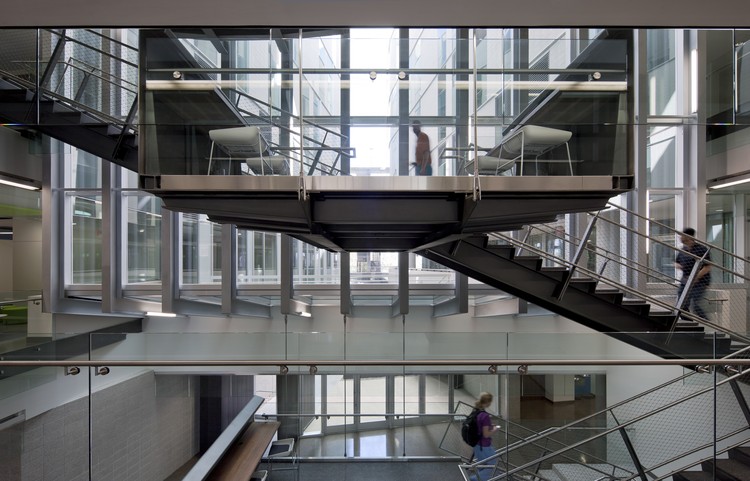
-
Architects: CO Architects
- Area: 268000 ft²
- Year: 2012
-
Photographs:Bill Timmerman
-
Manufacturers: TECU®, Hunter Douglas

Program
The University of Arizona (UA) College of Medicine-Phoenix, in partnership with and Northern Arizona University (NAU), is creating a new model for an integrated and interdisciplinary approach to health sciences education and research. Innovative in this endeavor is the collaboration and merging of these programs from two universities with distinct institutional cultures on one campus—Phoenix Biomedical Campus in downtown Phoenix.

The Health Sciences Education Building (HSEB) is part of the inter-institutional campus for health science education and research, and supports the colleges of medicine, allied health, and biomedical informatics. The new 268,000-square-foot, six-story facility consists of administration and faculty offices, lecture halls, learning studios, flexible classrooms, student and faculty services, clinical skills suite, simulation suite, gross anatomy facilities, class laboratories, learning resource center, cafeteria, student lockers, group study rooms, conference rooms and miscellaneous building support. HSEB and future research buildings are connected by a north- south structure that houses public functions and spaces for the occupants of these facilities as part of an effort to ensure that educators, researchers, students, and teachers meet and encourage an interdisciplinary approach to pedagogy and research.

A key characteristic of the program is a model of collective resources shared by the UA College of Medicine-Phoenix, the UA College of Pharmacy, and the UA Mel and Enid Zuckerman College of Public Health, as well as by Northern Arizona University’s College of Health and Human Services programs. An interactive planning process, which involved educators from the cross-section of health sciences disciplines, has worked collaboratively to create an educational vision of a team- based continuity of care model.

Design
The program and building design were developed by CO Architects to support an independent and collaborative health sciences education and research campus on a 28-acre urban setting in downtown Phoenix. The design for the Health Sciences Education Building (HSEB) draws inspiration from Arizona’s mountains and canyons and responds to the desert climate, characterized by intense sunlight and extreme temperatures. The siting of the building originates from the master plan by Ayers Saint Gross that establishes a north-south central campus green connecting the historic buildings to the south with future research facilities to the north.

The Arizona desert climate and need for reduced energy consumption informs much of the design for HSEB, from the siting to the fenestration. The facility is organized into east-west wings connected to a north-south axis establishing the eastern boundary of the campus. The building’s form and its orientation result from efforts to minimize the intense effects of the Arizona sun.

South-facing façades combine overhangs with perforated screens that function as sunshades; extensive studies of the window locations and the program requirements for the internal spaces informed the fenestration pattern as well as the shading devices. Vertical fins control sun penetration on the north. The wings are inflected to self-shade the walls and to create east-west “canyons.” Space between the two wings is tall and intentionally narrow. Windowless east and west façades are incised to create north and south fenestration. In the canyon, there are more glazed openings at the lower level with fewer windows near the top. Natural light is harnessed to flood the lower portions of the canyon with light. The canyon is clad in light-colored, burnished concrete block to provide cool thermal mass and reflectivity. At the top of the canyon is a PTFE (Polytetrafluoroethylene) scrim roof that helps regulates sunlight penetration. Exhaust air from the buildings heating, and cooling systems flow into the canyon because the exhaust air temperature is lower than the ambient outside air and therefore helps to cool the outdoor space. The project is targeting LEED®-NC Gold certification.

The canyon metaphor also applies to the materiality of the building. To connect the built environment to the surrounding landscape and bring nature into the heart of downtown Phoenix, the color and patina of the building skin draw from the peaks and mountains prevalent in Arizona. The striations of the surrounding mountains are abstracted by folding the building’s copper skin creating a visual connection to the surroundings.

HESB provides a range of established-to-vanguard skills-based and simulation settings that sustain the gamut of health sciences inter-professional training programs. This complex provides learning environments to train 1,200 medical professionals. It will also serve as a learning and teaching resource for the research community.






















